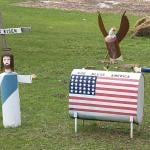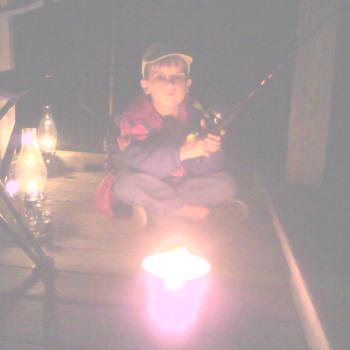Stressful situations can act like storms that threaten to capsize your mental health. Try using emotional anchors to keep yourself steady.

Recently, my father passed away. Stress and grief took their toll on me, even before traveling the 3,000 miles to be with family. In my mental discombobulation, I forgot to pack one travel essential I never leave home without—my prayer beads.
We arrived at my mother’s house and began preparing ourselves for the funeral and also for the inevitable family drama. My wife Christina could see that I was becoming agitated. So, she ordered some beads from Amazon, with next-day delivery. As I felt the tension of the upcoming days, this simple string of polished stones helped me to stay afloat.
Emotional Anchors
Emotional anchors are sensory supports that help you stay grounded, even when you feel storm-tossed or adrift. For me, prayer or meditation beads are tools that work like shortcuts to peace. When I’m feeling stressed, taking a moment and telling my rosary provides the breathing space I need to keep me calm. What emotional anchors work for you?
Though we probably don’t think of these articles of faith as emotional anchors, here are a few examples of shortcuts that often bring Christians a sense of instant peace:
- The weight and texture of a favorite Bible
- The sound of familiar hymns or worship songs
- The taste of bread and wine (or grape juice)
- The sight of icons, statues, or other religious art
- The smell of incense, anointing oil, or an old church building
You can add to the list of emotional anchors that hold significance for you. It almost doesn’t matter what the emotional anchor is, in and of itself. The key is that this sensory item grounds you. It works like a shortcut to peace that instantly transports you to a place of safety.
Security Blankets
Some may criticize emotional anchors as spiritual security blankets. They may suggest that emotional anchors are like Linus’s security blanket from the Peanuts cartoons. But the fact is that Linus was onto something. Emotional anchors, or even security blankets, are part of everyday adult life. The trick is understanding how they work and using them to your advantage.
In her YouTube video, “MENTAL ANCHORS ANXIETY RELIEF TECHNIQUE / how to use anchoring thoughts to relieve anxiety & panic,” Nena Lavonne explains how emotional anchors can help you counteract negative feelings, whether they are anticipated or whether they surprise you. Her video is worth the time it takes to watch.
Are Emotional Anchors Biblical?
If you’re still not convinced, here are some examples of emotional anchors employed by heroes of the Bible:
Moses’s Staff
Moses has an emotional anchor in the form of his staff. As it is something he can physically lean on, it becomes something he can emotionally rely on to support him as well. God demonstrates miraculous power by turning Moses’s staff into a serpent and then back into a staff. It may be the same staff that Aaron uses to combat the Egyptian magicians. Aaron also uses the rod to turn the Nile to blood, and to bring about the plagues of frogs and gnats. Moses employs the staff to call down the plague of hail and the plague of locusts.
We presume the staff is in Moses’s hand when he raises it to part the waters of the Reed Sea. With his rod, Moses strikes the rock to miraculously provide water for a thirsty nation. Later, Moses lifts his stick over a battlefield to encourage his Israelite warriors and defeat the Amalekites.
Each time the staff becomes a miraculous instrument, this further embeds the tool into Moses’s psyche as an emotional anchor. Moses feels a sense of power and peace whenever he carries it. Thus, the mere sight of God’s prophet raising his walking stick fills the Israelite’s hearts with confidence. For more on the staff of Moses, check out “The Staff of Moses” by Ismar Schorsch.
High Priests’ Divination Tools
In the Bible, high priests also have emotional anchors that they wear as part of their official garments. Each bears a breastplate made of a dozen precious stones that represent the twelve tribes of Israel. Attached to the breastplate, the priest also carries the Urim and Thummim. Together, the breastplate and Urim and Thummim serve as a divination tool by which the priests determine the will of God. During times of uncertainty, these tools provide an emotional anchor for the high priest and for national leaders who rely on these items to hear from God.
David’s Harp
The shepherd David finds his emotional anchor in the shape of a harp. In the wilderness, the sheep herder has few friends, but he does have his own music to keep him company. He passes many hours composing songs, singing praise to God, and playing on his harp. That instrument becomes an emotional anchor that instantly calms him whenever the need arises. This calming effect becomes so famous that when King Saul becomes moody, a court official suggests he invite the shepherd boy to play on his instrument. All it takes is a light strumming of the strings, and the evil mood lifts. David continues writing psalms for many years, and no doubt accompanied them on the harp.
Emotional Anchors’ Miraculous Effect
In each of these accounts, the emotional anchor becomes associated with a miraculous effect. Some might even call it magic. The marvelous qualities of an emotional anchor do not come from any inherent value. Moses did not carve his staff from enchanted wood. David does not stroke the strings of his harp through spell work. Instead, individuals imbue their emotional anchor with two powers stronger than any incantation.
The first power of an emotional anchor is that of belief. If I believe that breathing deeply while telling my prayer beads will bring me peace, then it will. If I believe that the aroma of anointing oil will usher me into God’s presence, then it will. These emotional anchors are more than a mental trick. They become a shortcut to divine experience.
The second power of an emotional anchor is that of love. Through constant use and connection to the individual, emotional anchors become infused with the power of love. If you can allow me the luxury of being a little woo-woo, the emotional anchor stores this love like a battery stores electricity. Whenever the individual is feeling low, they can connect with the emotional anchor to recharge from their own store of love-energies. Emotional anchors in Bible stories have a miraculous effect because of their connection to the power of love.
Good for Psychology and Spirituality Alike
For those seeking spiritual assurance, emotional anchors can be a shortcut to the divine. On the other hand, those who overlook the spiritual aspect can still find emotional anchors a useful tool for seeking psychological peace. Either way you approach it, an emotional anchor can be a quick way to hit the reset button when you find yourself in turmoil.
Could Emotional Anchors Help You?
Could emotional anchors help you to find inner peace? Consider what sensory objects you already find yourself returning to when you need comfort. Do you have a literal security blanket, scarf, piece of jewelry, or article of clothing? Try making this an intentional, rather than accidental, object of peace. Say to yourself, “Whenever I wear this, I am putting on love like a garment.” Do you have a favorite scented candle? Each time you light it, make it a prayer for peace. Does music move you? Try memorizing a song that ushers you into God’s presence every time. Are you motivated by liturgy? Try crossing yourself and reciting a pre-written prayer.
Emotional anchors work best when used often. Employ the same emotional anchor repeatedly until it becomes second nature—until peace comes just because you took the shortcut. Much as a ship’s anchor connects it to the ocean floor and prevents it from drift, an emotional anchor can help you stay grounded when you feel tossed by life’s waves.














